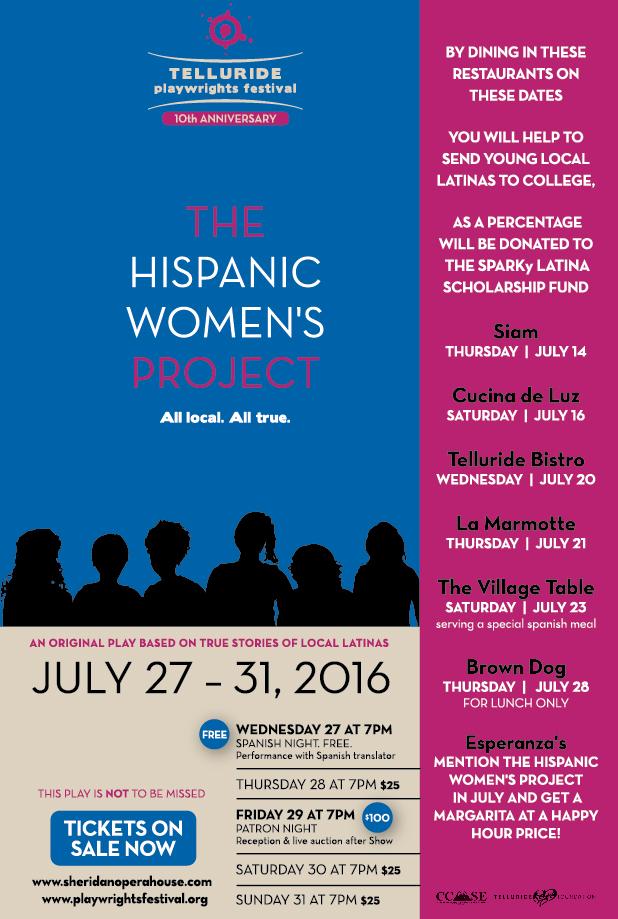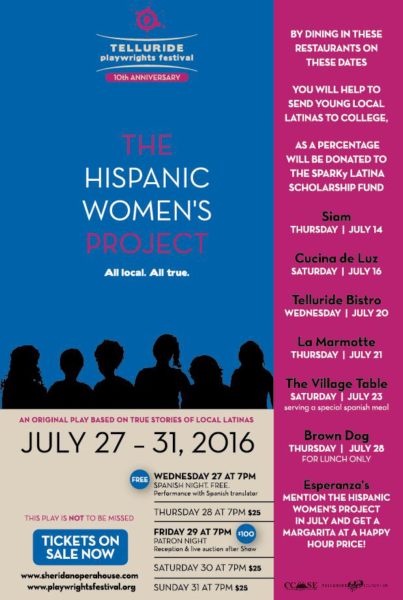
11 Jul Hispanic Women’s Project: History, Cause, Donation Dining & More
In celebration of the 10th anniversary of the Telluride Playwrights Festival, this year the Festival is mounting an original play devised and written by founder-director Jennie Franks. “The Hispanic Women’s Project” is based on true stories of local Hispanic women who live and work in this region. The stories told on stage – performed five nights at the Sheridan Opera House, Wednesday July 27 – Sunday, July 31– will serve to write new stories for young Latinas, because all funds raised from the play and ancillary events such as Donation Dining, will go towards a scholarship fund, with administrative help from the Telluride Foundation. That money will help a Latina high-school senior from the Telluride/Norwood Region attain in-state higher education. For more information on the festival. To purchase tickets, $25 or $100 for Patron’s Night, go here. To donate to The Latina Scholarship Program, go here.

At cultural events, festivals, theatrical performances, and other events, are you aware of how few Hispanics or Latinos (the terms are often used interchangeably) are in the crowd? Ever engage the person who fixes your car; is on the construction crew of a house nearby on the job every day; the person who serves your lunch or hands you a towel whenever you are working out or relaxing at a local spa; or even the person who cleans your own home, someone in regular, close proximity; ever ask anything of them about their day? Their life?
One person who has is Jennie Franks, founder and artistic director of the Telluride Playwrights Festival and SPARKy Productions.
To celebrate the 10th anniversary of The Telluride Playwrights Festival, Jennie devised and wrote “The Hispanic Women’s Project”; Yury Urnov of Washington D.C.’s Wooly Mammoth Theatre Company directs.
“The Hispanic Women’s Project” tells true stories of Hispanic women, who live and work in the San Miguel. They are stories of heartbreak and violence, of disappointment and bravery.
The women in the play all arrived in this country after a perilous journey crossing the border. They arrived with nothing more than the will to live a better life, from countries where starvation, violence, sexual assaults, lack of educational and work opportunities were facts of everyday life.
The first night of the show, July 27, is primarily for the Hispanic community, includes a translator and is free. Other nights are performed in English without translation.
The point of it? Yes, to tell awe-inspiring stories of strong women, modern immigrant stories right of the today’s headlines, and how those headlines are reflected in San Miguel County. But the production is also about raising awareness of the contributions the Hispanic community makes to the Telluride region by honoring bright promising young Latinas.
With support from partners, the Telluride School District, the Just for Kids Foundation, the Telluride Foundation (fund administrator), SPARKy Productions’ ticket and advertising sales of “The Hispanic Women’s Project” all go directly to benefit a scholarship fund designed to support a Latina high-school senior seeking a higher in-state eduction.
In addition to purchasing tickets for the show, or donating privately, you can support The SPARKy Latina Scholarship fund by bidding on one of many extraordinary auction items such as:
• 2 Nights for two at Inn of the Ancients with a gourmet dinner at Sutcliffe Vineyards.
• Six rounds of golf, plus dinner.
Starting bid for each of above, $500.
• 2 Prime tickets to see an OPERA live at the Met in NYC for 2016-17 Season. Opera of your choice.
Starting bid – $300.
• Dinner for two at one of the best restaurants in the country, the prestigious Stone Barns, Blue Hill restaurant at the old Rockefeller estate in the Hudson Valley. Starting bid, $600

Stone Barns, the old Rockefeller Estate in the Hudson Valley.

Blue Hill restaurant at Stone Barns.
• A week in Mexico as follows:
Lovely two-bedroom apartment in the exclusive Club Alexandra condominiums on Conchas Chinas Beach in Puerto Vallarta. Ocean view, steps to the beach. This is the perfect spot for a family vacation or a couple’s getaway. Lively downtown Puerto Vallarta is minutes away, or you can enjoy the privacy of sunset margaritas on your own terrace and a swim in the Club’s pool. (donated by Towbin/Barlow Family) Starting bid – $2500
Final bids accepted Friday, July 29, Patron’s Night.
The following items will be on Charity Buzz.
• Three nights at a spectacular villa at Amangiri in Utah.
Worth $31000. (sleeps 4 couples)
Starting bid – $9000

Amangiri, architect, Wendell Burnette
2. A week in Manzinillo at Palace By the Sea.
Sleeps 10.
Starting bid – $8,000
3. A week in Barbados at The Green Turtle Club and Resort
greenturtleclub.com
Starting bid – $900
Or participate in Donation Dining (as above).
Featured restaurants are Siam, Thursday, July 14; Cocina de Luz, Saturday, July 16; La Marmotte, Thursday, July 21; The Village Table in Mountain Villge (a special Spanish meal) on July 23; Brown Dog, Thursday, July 28 (Lunch only); and Esperanza’s (mention The Hispanic Women’s Project in July and get a Margarita at a Happy Hour price).
The Hispanic Women’s Project, the backstory:
It took some time and a lot of effort for Jennie Franks to connect the dots from concept to execution, establishing the necessary connections in the local Latino community and building trust, in part because most of the woman in “The Hspanic Women’s Project” are undocumented. So while all the stories are true, names and places have been changed.
Even though these are Latina immigrant stories, we can all relate; especially women. Theirs are stories that can be heard now in every part of America in Hispanic communities, stories of heartache, of sorrow and resilience. Th strength of these women, their drive to succeed and find a better life for themselves and their families, is awe-inspiring.
“The Hispanic Women’s Project” features six main stories and as many as 25 characters who appear from time to time throughout the play.
More about The Other:
Consciously or unconsciously, with or without malice aforethought, in our Wonder Bread town, Spanish-speaking people (other than tourists from South America or Mexico) are widely regarded as The Other, seen, but not seen as individuals, or as vital to Telluride’s service economy.
Who or what is The Other?
The notion of otherness is used by sociologists to highlight how social identities are contested. It is how many societies create a sense of belonging, identity, and social status by constructing social categories as binary opposites. According to social anthropologists, The Other is set up against the hegemonic “universal human being,” which in most Western contexts is white, upper- or middle-class, and until very recently, heterosexual.
“Otherness is a fundamental category of human thought. Thus it is that no group ever sets itself up as the One without at once setting up the Other over against itself,” argued author-activist Simone de Beauvoir in the early 1950s.
The truth is, your indifference – or at best, lack of awareness – may not matter to Hispanics living and working in the region. In a recent Pew study, Hispanics themselves appeared to be divided over how much of a common identity they share with Americans:
“About half (47%) say they consider themselves to be very different from the typical American. And just one-in-five (21%) say they use the term “American” most often to describe their identity.”
Still, the truth is, still, according to that same study, the U.S. is seen by Latinos as better than Latinos’ countries of origin in many ways.
“Fully 87% of Latino adults say the opportunity to get ahead is better in the U.S. than in the country of their ancestors; some 72% say the U.S. is better for raising children than their home country; nearly seven-in-ten (69%) say the poor are treated better in the U.S.; and a plurality of 44% say moral values are better here than in their homelands.”
And most Hispanic immigrants say they would migrate to the U.S. again:
“…Some 79% of Hispanic immigrants say that if they had to do it all over, they would come to the U.S., more than half (55%) of immigrant Hispanics say it was for economic reasons.”
Would they do it all over again despite how hard it was to cross the border; how difficult it is to assimilate, (if assimilation matters); and how hard it is to earn a living?
Food for thought, no?

The HIspanic Women’s Project marching in the Fourth of July parade. And towards scholarships for young Latinas.
The Hispanic Project: Excerpts
DREAMS
“I wanted to tell her the reason I’m here is because I had dreams. Ever since I was a little girl, I would dream of a better life in America, one where I could have a husband and children. A little girl. A sweet little girl, who I would call Lotte, and when she’s fifteen, we would give her a big party ‘a quinceanera’, one like I never had. And shoes. Real shoes that would protect her feet. And warm clothes in the winter and pretty dresses in the summer”
CROSSING THE BORDER
“ We had all gathered our money. We had to give her $4,000. I handed over $900. All together we gave her $4000 for our food. They didn’t charge the children for the food. I guess they thought the parents would share their food with them. Then another man came into the room. He was sweaty and he had a scar down his face. He put out his hand and snapped his fingers. We knew what he wanted. We gave him our money. Half of the cost of the border crossing money. It added up to just under $9,000 for all of us”
GROWING UP
“We listen to different music and we eat different food. It was hard to interact with the American kids. They don’t understand, they didn’t want to know me. And the Hispanic kids, the kids that should have been my friends, well; they didn’t want to know me either. Yeah, you could say I was lonely”
ARRIVING
“I don’t think you can appreciate what it’s like to walk down the street here in America for the very first time, when you’re from a poor county. To walk down a street paved not with gold but paved! The first time I walked down the street here in America, you know what I did? I bought an ice cream. I will never forget that day. It was the best day of my life. Strawberry ice cream in a sugar cone”
U. S. A
“Hey, You want to know something? America’s been good to me. I would serve this country if I were asked, because this country – I feel part of it, even though I’m not of it. My daughter and son are. They are of this country. They will take my American dream and make it bigger and better for them and their children”.


Sorry, the comment form is closed at this time.